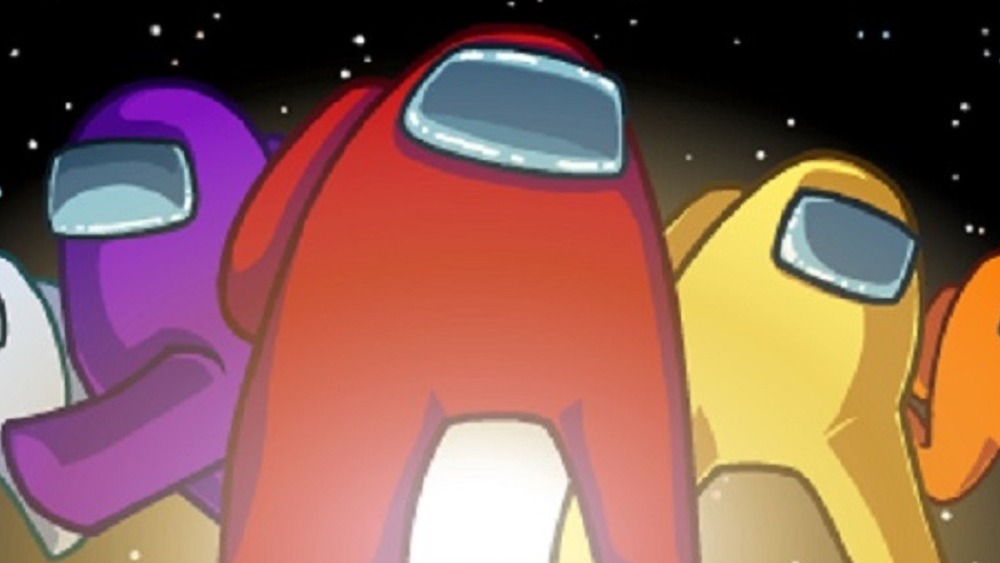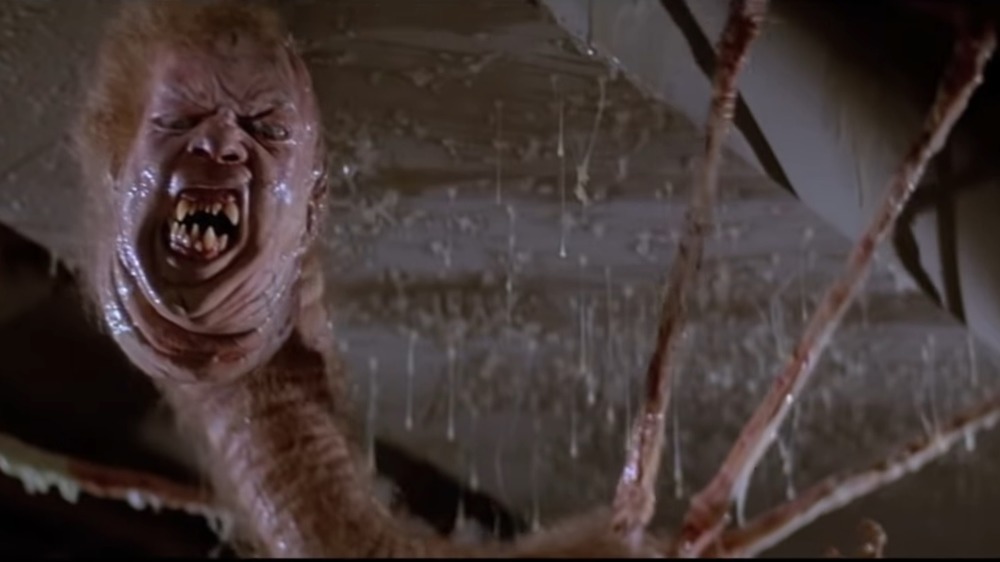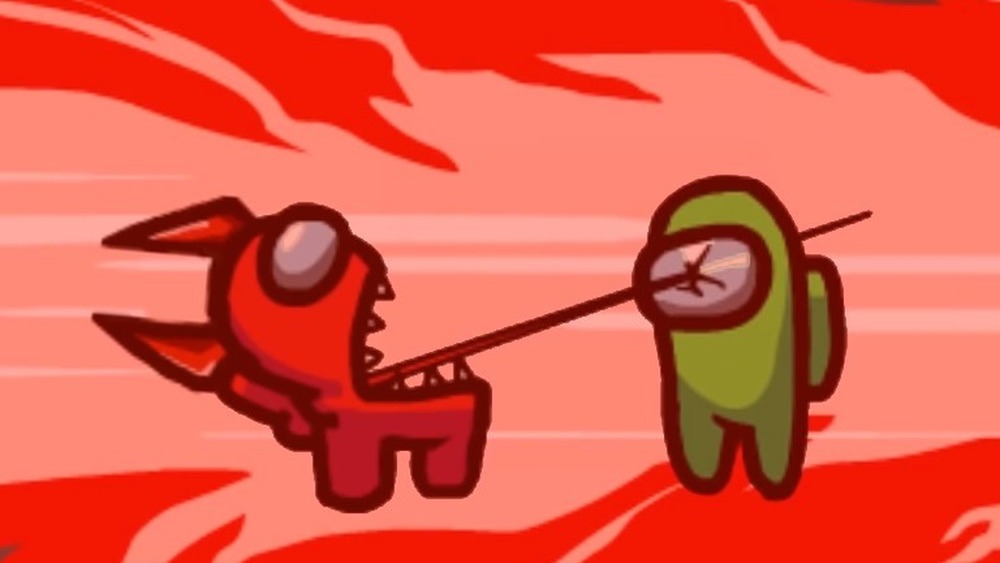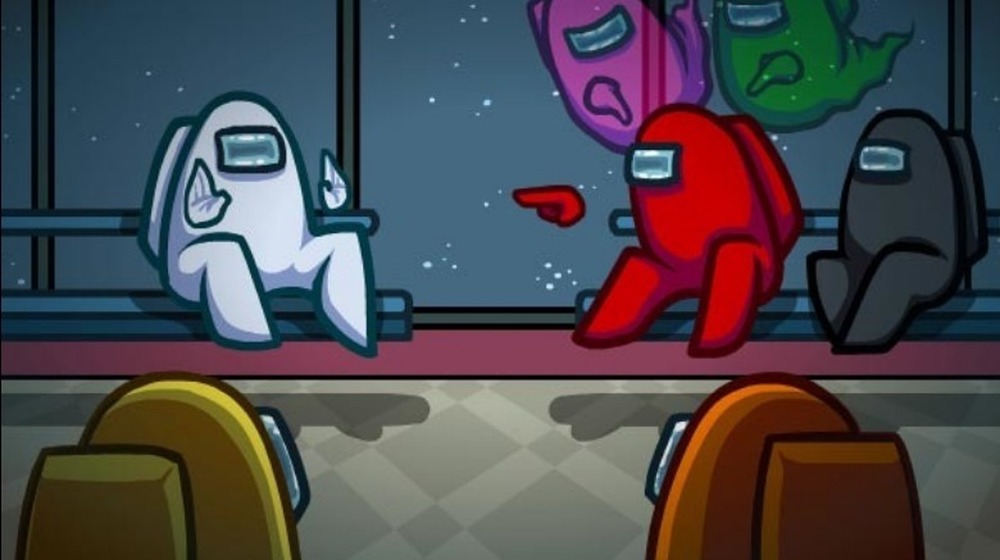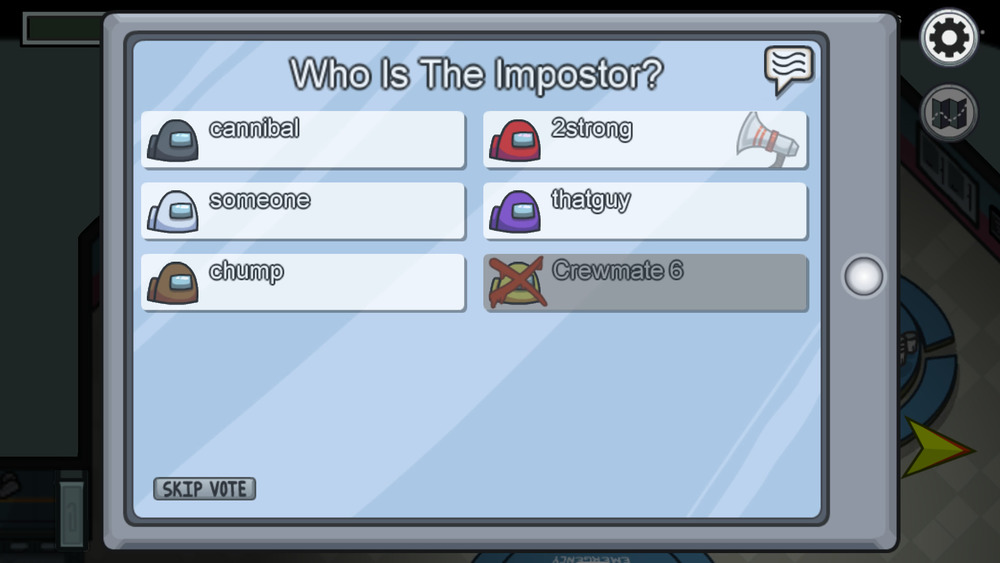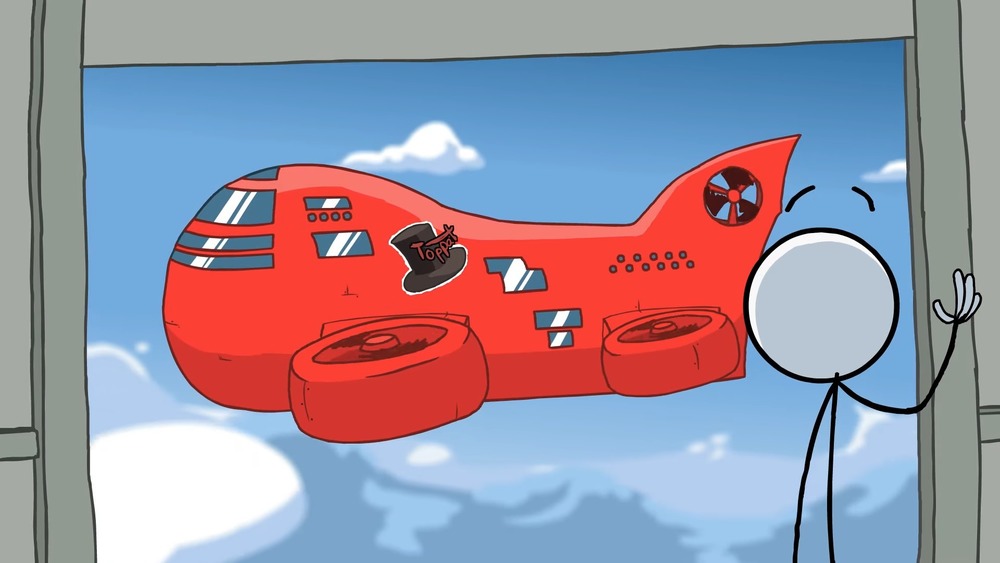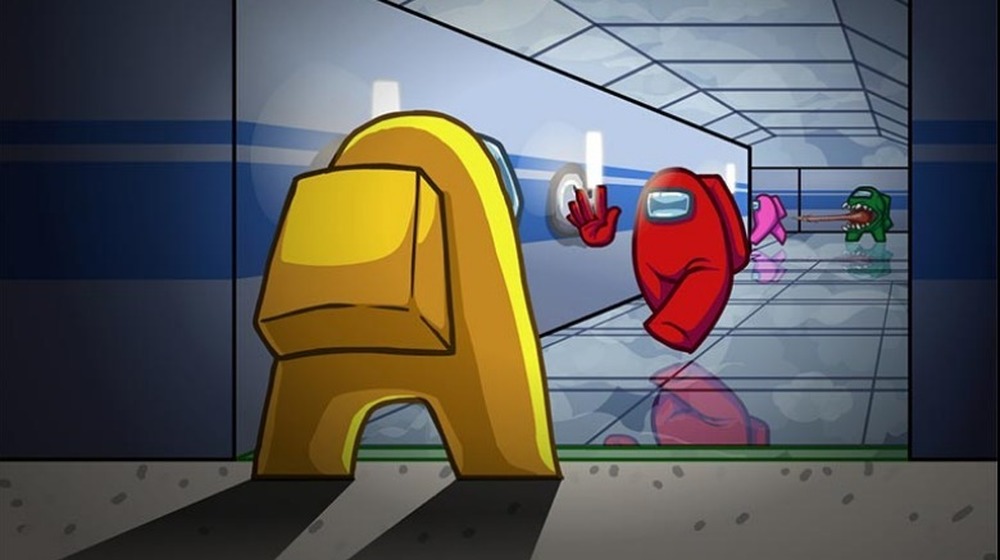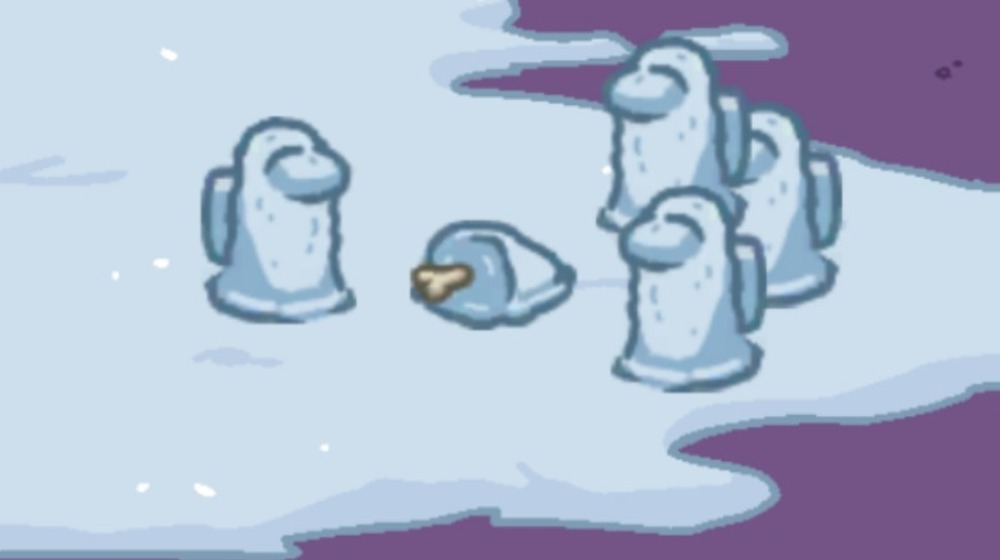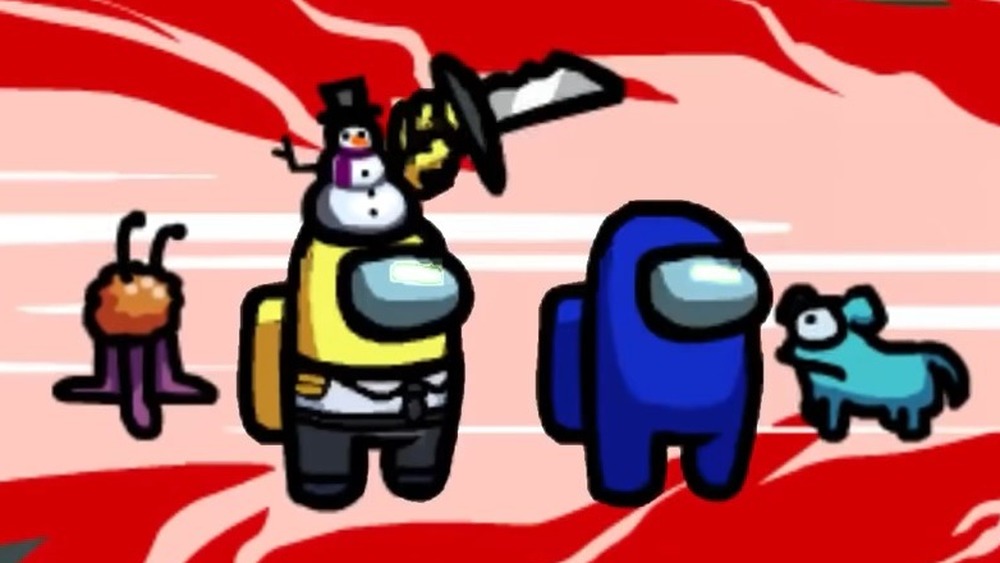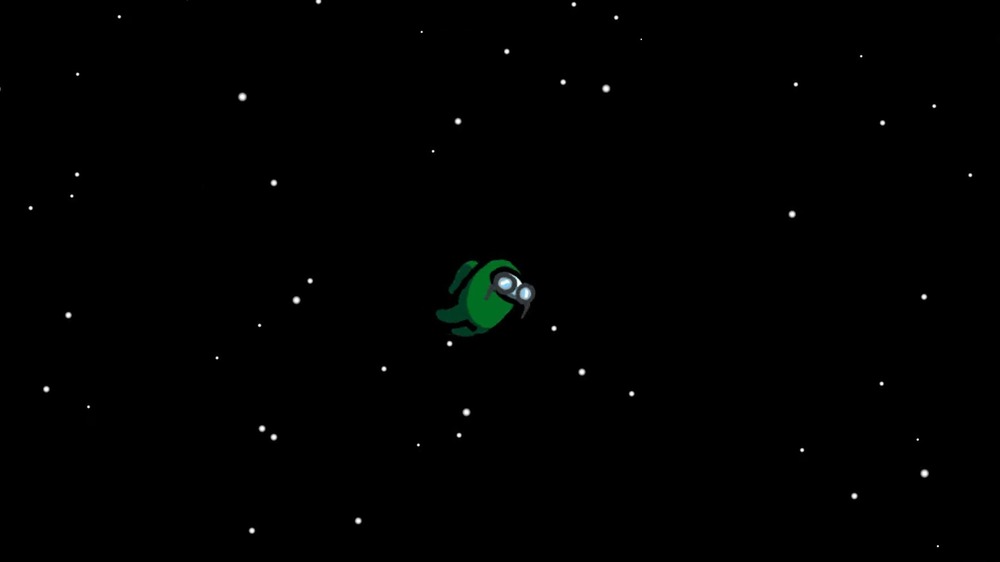Things Only Adults Notice In Among Us
Among Us is a fun, happy-go-lucky party game about space exploration, social deduction, and alien shapeshifters that want to eat your spine. The title has come a long way from its 2018 release. At first it was ignored, but then Fall Guys came along and inspired gamers to find more titles that star sentient jellybeans out to get each other. One of the games audiences discovered was Among Us. The title's newfound success was so sudden and overwhelming that developer Innersloth decided to cancel a sequel.
Since Innersloth also developed The Henry Stickmin Collection, the studio carried over its comedy stylings and love of references to Among Us. Many of these jokes and references might go over younger gamers' heads. In fact, Among Us is packed with many details that you probably wouldn't notice unless you're old enough to join NASA. Here are a small number of factoids locked behind the age gate.
It combines elements of The Thing and Alien
Even though Among Us' cute little characters don't have sleeves, the game wears its inspirations on its own. Yes, inspirations as in plural, but you might not recognize them unless you grew up in an age when movies lacked CGI.
Since Among Us is all about sussing out a parasitic and murderous imposter, its first inspiration is, fittingly, the ultimate movie about sussing out a parasitic and murderous imposter: 1982's The Thing. In the movie, the alien can move around in plain sight and kill in the shadows, and its best survival tool is the ability to sow dissent and promote paranoia. Ask any expert Among Us player, and they will probably say the best way to kill crew members is to make them turn on each other.
Among Us' other inspiration is the archetypal film about an alien on a spaceship: Alien. This influence isn't as overt as The Thing, but Alien left its mark. Imposters in the game are known for, among other things, their love of traveling through vents, and Alien's xenomorph has a nasty habit of slinking through space stations in vents.
Nobody's human in Among Us, not even the crewmates
Since Among Us' imposters are alien shapeshifters, common trope knowledge would dictate all the crewmates are human. Cartoonishly rendered humans, but humans nonetheless. However, this isn't true, and we have the Body Mass Index (BMI) to thank for this knowledge.
In Among Us, the best way to prove a crewmate's innocence is the MedBay's scanner. It provides their biometrics, from their height (3'6") to their weight (92 pounds). If you are a child, you probably don't think those measurements are strange. However, many adults and physicians recognize these numbers as red flags. According to the CDC, every crewmate has a BMI of 36.7, which means they are very obese.
A high BMI by itself does not disprove someone's humanity, but performing a ton of physical labor and maintaining that specific BMI universally among all crewmates is beyond suspicious. Furthermore, crewmate anatomy is another deciding factor. Whenever a crewmate dies, they leave behind a corpse with one bone. That isn't a cartoonish representation to tone down the game's age rating. Innersloth confirmed that singular bone is the only one in their body.
An active lifestyle combined with such a high BMI, as well as 205 bones unaccounted for, means crewmates ain't human.
You're doomed unless you eject the imposters (and even then you're doomed)
If you're a crewmate in Among Us, you might want to just go about your business and complete all of your tasks before you're gruesomely murdered. If you do that, the game claims you've "won," but according to in-game canon, that's exactly why imposters are such a huge problem.
The game's official DLC descriptions state MIRA HQ and Polus should be imposter free, yet shapeshifters infect those locations. Even though the game claims crewmates win if they keep the ship up and running, that's only in the short run. In the long run, once all the tasks are complete, the imposters are free to kill all the remaining crewmates since in reality decisions aren't stuck in a compartmentalized vacuum.
The only true way to ensure a crew's safety is to eject all the imposters, but then the crewmates are only safe until they dock. After that, the surviving team is potentially cross-contaminated with a new team that fixed their ship instead of hunted imposters, which means the threat starts all over again.
The mantra "Stay calm and carry on" does not apply when you have to think ahead to root out murderous shapeshifters. Most children haven't mastered the art of planning ahead like that.
Information is power
Determining between a harmless spaceman and a murderous alien is as easy as examining the facts. When anyone can be an alien, the facts can easily be manipulated. But on the flipside, the manipulation of facts can leave a trail of breadcrumbs most children would ignore.
The most reliable way to determine whether someone is an imposter is to catch them in the act. Seeing is believing, after all, so imposters need to leave everyone in the dark — figuratively and literally. By sabotaging the lights, they can basically kill any crewmate they want, and once the corpse is reported, nobody will know where anyone was in regards to anyone else at the time of the murder. Voting goes from information-based to a random shot in the dark.
Alternatively, crewmates can suss out the guilty party, or at least their accomplice, by deciphering subtle behavioral hints. Did they see a player "complete" a task without affecting the task progress bar? Was one player hesitant to vote off a known imposter — or anyone else for that matter? These could be surefire signs of an evil doppelganger.
Actions speak louder than words, so if someone sounds suspicious, don't throw them out the airlock just yet. See if they act suspicious.
Among Us and Henry Stickmin are part of the Innerslothverse
Many studios like to reference their older works, but these are usually tongue-in-cheek nods to what came before. Mass Effect 2 and 3's Blood Dragon Armor does not prove the franchise is canonically connected to Dragon Age. But there are always exceptions to the rule, and Among Us is one of them.
Among Us' latest map, The Airship, is modeled after the Toppat Clan Airship from The Henry Stickmin Collection, but it isn't Innersloth's way of tipping its hat to previous work. Among Us and Henry Stickmin share the same universe, which means The Airship is canon in Among Us lore.
How can you know the two games are connected? Look no farther than the icy planet of Polus, which shares its name with the Henry Stickmin character Polus Petrovich. This name sharing isn't coincidence since Petrovich's bio clearly states, "He won a sweepstakes and got to name a planet after himself." That planet is none other than Polus — unless Innersloth wants gamers to believe that somewhere in the Henry Stickmin universe floats the planet of Petrovich. Still, odds are children would never make this connection.
The space suits, they do nothing!
Clothes don't just make the man/woman: they also reflect the profession. If you work in a dirty environment, you won't wear anything fancy, a concept that is beyond most children — just ask any parent who cleans muddy clothes. In fact, you usually receive a uniform that is easily cleaned. Likewise, if you work in a dangerous location, you wear clothes that protect you. When your job is based in the cold depths of space, you might expect a suit to safeguard you from an oxygen-free vacuum. Apparently, that isn't within the budget for Among Us' workers.
One of the most diabolical sabotages at imposter disposal is oxygen depletion since it can result in an instant imposter win. That shouldn't be possible if crewmates wear spacesuits, and it certainly looks like they do, complete with oxygen supply backpacks. But, since crewmates can asphyxiate, that clearly isn't the case.
If crewmates aren't wearing spacesuits, then what are they wearing? Possibly work uniforms meant to protect them from workplace hazards instead of the inhospitable void of space. And as for the backpacks, they might just be simple tool packs. Unfortunately, the suits don't do much against the piercing tongues of imposters — or mob mentality-induced paranoia.
The crewmates have accepted death as a daily part of life
What do you do when you put your life on the line every day for a job? Thanks to Child Labor Laws, kids don't have to know about experiencing mental breakdowns or finding ways to cope. As you'll learn while playing Among Us, the crewmates in the game might have done both.
Among Us' third map, Polus, is an arctic research facility obviously surrounded by snow. If you wander the base, you will find snowmen that crewmates have probably built in the pursuit of entertainment. However, some snowmen recreate a murder scene, which implies crewmates have accepted death by imposter as an inescapable fact of life. Why else would anyone create such a grisly diorama? There is another explanation.
If you look closely at the snowcorpse, you notice its bone isn't made of snow. This could point to one of two possibilities: either crewmate coping mechanisms sunk to such perverse extremes that they recycle their friends to make snowmen, or an imposter killed a crewmate outside and hid it in plain sight. But if the latter is true, that raises another question: Did the imposter make the other snowmen, or was it the crewmates?
Scar your pet for life
When you die in Among Us, your disembodied spirit floats around the map, cursed to an afterlife tethered to your bloodstain. Normally, death would only affect the players since one dead crewmate means one less obstacle in the imposters' way. But if you have a pet, you will witness a scene that will bring tears to your eyes.
If you lug around a pet and are killed by an imposter, your little buddy will escape unharmed, but they will never be the same again. Not only do they react to your death with absolute terror, but they will refuse to move from the spot and mourn you. Each pet sports a unique animation, each more heart-wrenching than the last.
The brainslug, dog, squig, and bedcrab, for example, squeeze themselves as close to the floor as possible; Henry sobs uncontrollably, and the hamster desperately looks for its owner. The animations, while simple, convey that each pet's heart is broken when they see their crewmate killed. The pets might still be alive physically, but they are clearly dead inside, as demonstrated by body language some children might not understand.
Crew Expendable
To quote Spock, "The needs of the many outweigh the needs of the few." If one person's sacrifice can save countless other lives, then it is probably a sacrifice worth making. The same rule applies in Among Us since crewmates are dealing with an insidious threat. Look no further than game theory, which most people don't learn about until college, for proof.
According to the game theory that economists (and the YouTube channel Game Theory) use, crewmates are less valuable than imposters simply by virtue of being more numerous. Crewmates can therefore afford losing a hand or two in the search for imposters because they have more bodies to throw out the airlock. Imposters, meanwhile, lose half their manpower if one is ejected.
Whenever you pay attention to players trying to defend their innocence, pay closer attention to those who counter them. Who is arguing for a guilty verdict? If you vote one player off the ship and they aren't an imposter, don't let them die in vain. Use them as a sacrificial mole to gather information and pin the real imposter. If one player's claims contradict the dead player's statements, you might have found your imposter, and it only cost an expendable life.

